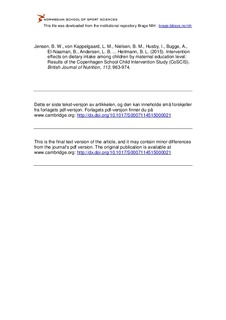| dc.contributor.author | Jensen, Britt Wang | |
| dc.contributor.author | von Kappelgaard, Lene Mia | |
| dc.contributor.author | Nielsen, Birgit Marie | |
| dc.contributor.author | Husby, Ida | |
| dc.contributor.author | Bugge, Anna | |
| dc.contributor.author | El-Naaman, Bianca | |
| dc.contributor.author | Andersen, Lars Bo | |
| dc.contributor.author | Trolle, Ellen | |
| dc.contributor.author | Heitmann, Berit Lilienthal | |
| dc.date.accessioned | 2016-05-25T09:57:08Z | |
| dc.date.available | 2016-05-25T09:57:08Z | |
| dc.date.issued | 2015-03 | |
| dc.identifier.citation | British Journal of Nutrition. 2015, 113, 963-974 | nb_NO |
| dc.identifier.uri | http://hdl.handle.net/11250/2390326 | |
| dc.description | Dette er siste tekst-versjon av artikkelen, og den kan inneholde små forskjeller fra forlagets pdf-versjon. Forlagets pdf-versjon finner du på www.cambridge.org: http://dx.doi.org/10.1017/S0007114515000021 / This is the final text version of the article, and it may contain minor differences from the journal's pdf version. The original publication is available at www.cambridge.org: http://dx.doi.org/10.1017/S0007114515000021 | nb_NO |
| dc.description.abstract | Dietary intake among Danish children, in general, does not comply with the official recommendations. The objectives of the present study were to evaluate the 3-year effect of a multi-component school-based intervention on nutrient intake in children, and to examine whether an intervention effect depended on maternal education level. A total of 307 children (intervention group: n 184; comparison group: n 123) were included in the present study. All had information on dietary intake pre- and post-intervention (mean age 6·8 and 9·5 years for intervention and comparison groups, respectively) assessed by a 7-d food record. Analyses were conducted based on the daily intake of macronutrients (energy percentage (E%)), fatty acids (E%), added sugar (E%) and dietary fibre (g/d and g/MJ). Analyses were stratified by maternal education level into three categories. Changes in nutrient intake were observed in the intervention group, mainly among children of mothers with a short education ( < 10 years). Here, intake of dietary fibre increased (β = 2·1 g/d, 95 % CI 0·5, 3·6, P= 0·01). Intake of protein tended to increase (β = 0·6 E%, 95 % CI − 0·01, 1·2, P= 0·05), while intake of fat (β = − 1·7 E%, 95 % CI − 3·8, 0·3, P= 0·09) and SFA (β = − 0·9, 95 % CI − 2·0, 0·2, P= 0·10) tended to decrease. Also, a significant intervention effect was observed on the intake of SFA among children of mothers with a long education (β = − 0·8, 95 % CI − 1·5, − 0·03, P= 0·04). This multi-component school-based intervention resulted in changes in the dietary intake, particularly among children of mothers with a short education. As the dietary intake of this subgroup generally differs most from the recommendations, the results of the present study are particularly encouraging. | nb_NO |
| dc.language.iso | eng | nb_NO |
| dc.publisher | Cambridge University Press | nb_NO |
| dc.subject | school-based intervention | nb_NO |
| dc.subject | maternal education | nb_NO |
| dc.subject | diet | nb_NO |
| dc.subject | macronutrients | nb_NO |
| dc.title | Intervention effects on dietary intake among children by maternal education level: results of the Copenhagen School Child Intervention Study (CoSCIS) | nb_NO |
| dc.type | Journal article | nb_NO |
| dc.type | Peer reviewed | nb_NO |
| dc.subject.nsi | VDP::Mathematics and natural science: 400 | nb_NO |
| dc.subject.nsi | VDP::Mathematics and natural science: 400::Basic biosciences: 470 | nb_NO |
| dc.subject.nsi | VDP::Medical disciplines: 700 | nb_NO |
| dc.subject.nsi | VDP::Medical disciplines: 700::Basic medical, dental and veterinary science disciplines: 710 | nb_NO |
| dc.subject.nsi | VDP::Medical disciplines: 700::Clinical medical disciplines: 750 | nb_NO |
| dc.subject.nsi | VDP::Medical disciplines: 700::Health sciences: 800 | nb_NO |
| dc.source.journal | British Journal of Nutrition | nb_NO |
| dc.description.localcode | Seksjon for idrettsmedisinske fag / Department of Sport Medicine | nb_NO |
